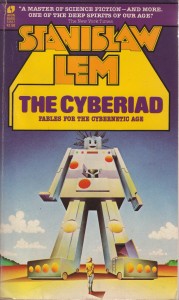 Stanislaw Lem’s works can be roughly divided into fiction, essays, apocrypha (texts about non-existent texts) and complains about the literary critique. It may seem strange that a popular writer, whose books have been published all over the world, grieved that reviews did not do him justice. Over time, on both sides of the Iron Curtain enthusiastic, in-depth, competent articles started to appear, such as the extensive texts of „The New York Times Book Review”. However there were few general overviews combining elements shared by a number of works and presenting universal attributes of Lem’s literary output. Most lemologists — usually humanists — were somewhat crestfallen by the spectrum of knowledge and erudition of an author who „like an intellectual bulldozer with astonishing ease dug through all possible fields of human cognition”1. Lem’s reception was also disturbed by the stigmatizing „science fiction” label.
Stanislaw Lem’s works can be roughly divided into fiction, essays, apocrypha (texts about non-existent texts) and complains about the literary critique. It may seem strange that a popular writer, whose books have been published all over the world, grieved that reviews did not do him justice. Over time, on both sides of the Iron Curtain enthusiastic, in-depth, competent articles started to appear, such as the extensive texts of „The New York Times Book Review”. However there were few general overviews combining elements shared by a number of works and presenting universal attributes of Lem’s literary output. Most lemologists — usually humanists — were somewhat crestfallen by the spectrum of knowledge and erudition of an author who „like an intellectual bulldozer with astonishing ease dug through all possible fields of human cognition”1. Lem’s reception was also disturbed by the stigmatizing „science fiction” label.
Chlorian Theoreticus the Proph, a character from Lem’s „Tale of the Three Storytelling Machines of King Genius,” is an ironically bitter self-portrait2 of the author himself — a writer and thinker ignored and underestimated by his contemporaries. The unfortunate Chlorian created works of art „saturated with the absolute,” brilliant masterpieces reaching the very core of the essence of things. After the (self) publication of his first book the philosopher expected to be welcomed by enthusiastic crowds:
As soon as this treatise appeared in print (at my own expense), I rushed out into the street, certain that the people would lift me up on their shoulders, crown me with garlands, shower me with gold, but no one, not even so much as a lame cybernerian, approached with words of praise.
As befitted a true sage, Chlorian initially accepted failure philosophically:
‚My time will come!’ I told myself. ‚It cannot be, for someone to cast forth pearls of eternal wisdom left and right, day and night, till the mind is blinded by the surging Light of Final Understanding—and nothing! No, fame will be mine, acclaim will be mine, thrones of ivory, the title of Prime Mentorian, the love of the people, sweet solace in a shaded grove, my very own school, pupils that hang on every word, and a cheering crowd!’
Undeterred Chlorian produced more staggeringly philosophical works — also ignored. Over the years bitterness and discouragement settled in, while all honors went to royal favorites, whose shallow and worthless output the readers seemed to prefer:
You see, I would occasionally purchase the works of other sages, who enjoyed great riches and the sweets of success, to learn what sort of things they wrote about. Well, they wrote about the difference between the front and the rear, about the wondrous structure of the Tyrant’s throne, its sweeping arms and all-enduring legs, and tracts about good manners, and detailed descriptions of this and that, during which no one ever praised himself in any way, and yet it worked out somehow that Phrensius stood in awe of Schneckon, and Schneckon of Phrensius, while both were lauded by the Logarites.
What was the later fate of Chlorian (aka Lem)? Lem wrote „Tale of the Three Storytelling Machines of King Genius” (from “The Cyberiad”) at the beginning of the 1960s, on the threshold of his international fame. His books were published in over forty languages, their joint print-run exceeded thirty million copies. Half a century later, when even Google paid a tribute to Lem with an interactive Doodle (that was one fine Doodle, which captivated Lem’s fans all over the world) it seems that it didn’t turn out that bad after all…
1. S. Bereś, Uniwersum Stanisława Lema, “Odra” 1980, nr 3
2. Chlorian Theoreticus the Proph is me in about 60%, dear Sir, i.e. it describes my condition of „general obscurity” (“Fame and Fortune. Stanisław Lem’s letters to Michael Kandel”, Wydawnictwo Literackie, Kraków 2013, p. 49)

It’s strange that the writer hasn’t kept in touch with Lem’s later career: all his books in print for many years from HBJ, a second film made of Solaris, and (I would have thought) constant discussion of his works in the serious SF press. Certainly in SF Commentary and Steam Engine Time, where George Zebrowski conducted a vigorous discussion about Lem in recent years.